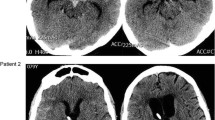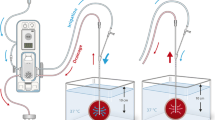Summary
Six patients with recently ruptured intracranial aneurysms were treated preoperatively with tranexamic acid (AMCA). Two patients received 6 g daily in i.v. infusion, two had 6 g daily by i.v. injection, and two patients were given AMCA 9 g daily by mouth during the first week after bleeding. Serial assays of AMCA and fibrin/fibrinogen degradation products (FDP) in cerebrospinal fluid (CSF) were performed during 6–13 days after the initial subarachnoid haemorrhage (SAH). Judged from the decline in CSF-FDP, an assumed therapeutic level of ≥ 1 mg/l of AMCA in CSF was reached within 24–36 hours after the first dose when the drug was administered intravenously and within 48 hours when the drug was given orally.
Similar content being viewed by others
References
Alvarez Garijo, J. A., Vilches, J. J., Aznar, J. A., Preoperative treatment of ruptured intracranial aneurysms with tranexamic acid and monitoring of fibrinolytic activity. J. Neurosurg.52 (1980), 453–455.
Andersson, L., Eriksson, O., Hedlund, P. O., Kjellmann, H., Lindqvist, B., Special considerations with regard to the dosage of tranexamic acid in patients with chronic renal diseases. Urol. Res.2 (1978), 83–88.
Andersson, L., Nilsson, I. M., Colleen, S., Granstrand, B., Melander, B., Role of urokinase and tissue activator in sustaining bleeding and the management thereof with EACA and AMCA. Ann. N.Y. Acad. Sci.146 (1968), 642–658.
Andersson, L., Nilsson, I. M., Niléhn, J. E., Hedner, U., Granstrand, B., Melander, B., Experimental and clinical studies on AMCA, the antifibrinolytically active isomer of p-aminomethyl cyclohexane carboxylic acid. Scand. J. Haematol.2 (1965), 230–247.
Botterell, E. H., Lougheed, W. M., Scott, J. W., Vanderwater, S. L., Hypothermia and interruption of carotid, or carotid and vertebral circulation, in the surgical treatment of intracranial aneurysms. J. Neurosurg.13 (1956), 1–42.
Brueton, M. J., Breeze, G. R., Stuart, J., Fibrin-fibrinogen degradation products in cerebrospinal fluid. J. Clin. Pathol.29 (1976), 341–344.
Brueton, M. J., Tugwell, P., Whittle, H. C., Greenwood, B. M., Fibrin degradation products in the serum and cerebrospinal fluid of patients with group A-meningococcal meningitis. J. Clin. Pathol.27 (1974), 402–404.
Chandra, B., Treatment of subarachnoid hemorrhage from ruptured intracranial aneurysm with tranexamic acid: A double-blind clinical trial. Ann. Neurol.3 (1978), 502–504.
Donner, L., Housková, J., Fibrinolytic activity of tissues in some experimental animals. In: Acta of the First International Symposium on Tissue Factors in Homeostasis of the Coagulation-Fibrinolysis System, pp. 319–328. Florence 1967.
Dubber, A. H. C., McNicol, G. P., Douglas, A. S., Amino methyl cyclohexane carboxylic acid (AMCHA). A new synthetic fibrinolytic inhibitor. Br. J. Haemat.11 (1965), 237–245.
Dubber, A. H. C., McNicol, G. P., Douglas, A. S., Melander, B., Some properties of the antifibrinolytically active isomer of amino-methylcyclohexane carboxylic acid. LancetII (1964), 1317–1319.
Eriksson, O., Kjellman, H., Pilbrant, Å., Schannong, M., Pharmacokinetics of tranexamic acid after intravenous administration to normal volunteers. Eur. J. Clin. Pharmacol.7 (1974), 375–380.
Filizzolo, F., D'Angelo, V., Collice, M., Ferrara, M., Donati, M. B., Porta, M., Fibrinolytic activity in blood and cerebrospinal fluid in subarachnoid hemorrhage from ruptured intracranial saccular aneurysm before and during EACA treatment. Eur. Neurol.17 (1978), 43–47.
Fodstad, H., Forssell, Å., Liliequist, B., Schannong, M., West, K. A., Antifibrinolytics and subarachnoid haemorrhage: Results from two controlled clinical trials using tranexamic acid (AMCA). Acta neurochir. (Wien)51 (1979), 131 (Abstr.).
Fodstad, H., Liliequist, B., Schannong, M., Thulin, C.-A., Tranexamic acid in the preoperative management of ruptured intracranial aneurysms. Surg. Neurol.10 (1978), 9–15.
Hassler, O., Fodstad, H., Fibrinolytic activity in the walls of cerebral saccular aneurysms. Acta neurochir. (Wien)37 (1977), 49–55.
Hellinger, J., Vogel, G., Untersuchungen über die fibrinolytische Aktivität des Liquor cerebrospinalis und ihre Beeinflußbarkeit durch PAMBA. Folia Haematol. (Leipzig)87 (1967), 61–66.
Kaller, H., Enterale Resorption, Verteilung und Elimination von 4-Aminomethylcyclohexancarbonsäure (AMCHA) und e-Aminocapronsäure (ACS) beim Menschen. Naunyn-Schmiedebergs Arch. Pharmacol.256 (1967), 160–168.
Kaste, M., Ramsay, M., Tranexamic acid in subarachnoid hemorrhage. A double-blind study. Stroke10 (1979), 519–522.
Levy, B. J., Silver, D., Treatment of subarachnoid hemorrhage: The ability of epsilon aminocaproic acid to cross the blood brain barrier and reduce the spinal fluid fibrinolytic activity. Surg. Forum19 (1968), 413–414.
Locksley, H. B., Report on the cooperative study of intracranial aneurysm and subarachnoid hemorrhage. Section V. Part II. Natural history of subarachnoid hemorrhage, intracranial aneurysms and arteriovenous malformations. Based on 6,368 cases in the cooperative study. J. Neurosurg.25 (1966), 321–368.
Maurice-Williams, R. S., Prolonged antifibrinlysis: an effective non-surgical treatment for ruptured intracranial aneurysms? Brit. Med. J.1 (1978), 945–947.
Maurice-Williams, R. S., Gordon, Y. B., Sykes, A., Monitoring fibrinolytic activity in the cerebrospinal fluid after subarachnoid haemorrhage: a guide to the risk of rebleeding? J. Neurol. Neurosurg. Psychiat.43 (1980), 175–181.
Mihara, H., Fujii, T., Okamoto, S., Fibrinolytic activity of cerebrospinal fluid and the development of artificial cerebral haemorrhage. Thrombos. Diathes. haemorrh. (Stuttg.)21 (1969), 294–303.
Niléhn, J.-E., Split products of fibrinogen after prolonged interaction with plasmin. Thrombos. Diathes. haemorrh. (Stuttg.)18 (1967 a), 89–100.
Niléhn, J.-E., Separation and estimation of “split products” of fibrinogen and fibrin in human serum. Thrombos. Diathes. haemorrh. (Stuttg.)18 (1967 b), 487–498.
Nilsson, I. M., Haemorrhagic and Thrombotic Diseases, 228 pp. London-New York-Sydney-Toronto: J. Wiley & Sons. 1974.
Norlén, G., Thulin, C.-A., Antifibrinolytisk behandling vid intrakraniell aneurysmblödning. Läkartidningen65 (1968), 2910–2912.
Pilbrant, Å., Schannong, M., Vessman, J., Sci. Rep. 79 99 041, Data on file, Kabi AB, Stockh. Sweden, 1979.
Porter, I. M., Acinapura, A. J., Kapp, J. P., Silver, D., Fibrinolytic activity of the spinal fluid and meninges. Surg. Forum17 (1966), 425–427.
Rossum, J. van, Wintzen, A. R., Endtz, L. J., Schoen, J. H. R., Jonge, H., Effect of tranexamic acid on rebleeding after subarachnoid hemorrhage: A double-blind controlled clinical trial. Ann. Neurol. (1977), 238–242.
Smith, R. S., Upchurch, J. J., Monitoring antifibrinolytic therapy in subarachnoid hemorrhage. J. Neurosurg.38 (1973), 339–344.
Tanaka, M., Studies on the fibrinolytic system in cerebrospinal fluid and brain tissue. Arch. Jap. Chir.29 (1960), 449–456.
Tovi, D., Nilsson, I. M., Increased fibrinolytic activity and fibrin degradation products after experimental intracerebral haemorrhage. Acta Neurol. Scand.48 (1972), 403–415.
Tovi, D., Nilsson, I. M., Thulin, C.-A., Fibrinolysis and subarachnoid-haemorrhage. Inhibitory effect of tranexamic acid. A clinical study. Acta Neurol. Scand.48 (1972), 393–402.
Tovi, D., Nilsson, I. M., Thulin, C.-A., Fibrinolytic activity of the cerebrospinal fluid after subarachnoid haemorrhage. Acta Neurol. Scand.49 (1973), 1–9.
Tovi, D., Thulin, C.-A., Ability of tranexamic acid to cross the blood-brain barrier and its use in patients with ruptured intracranial aneurysms. Acta Neurol. Scand.48 (1972), 257 (Abstr.).
Vessman, J., Strömberg, S., Determination of tranexamic acid in biological material by election capture gas chromatography after direct derivatization in an aqueous medium. Analyt. Chem.49 (1977), 369–373.
Åstedt, B., Liedholm, P., Tranexamic acid and fibrinolytic activity of the vessel wall. Experientia30 (1974),776–777.
Author information
Authors and Affiliations
Rights and permissions
About this article
Cite this article
Fodstad, H., Pilbrant, A., Schannonǵ, M. et al. Determination of tranexamic acid (AMCA) and fibrin/fibrinogen degradation products in cerebrospinal fluid after aneurysmal subarachnoid haemorrhage. Acta neurochir 58, 1–13 (1981). https://doi.org/10.1007/BF01401679
Issue Date:
DOI: https://doi.org/10.1007/BF01401679




